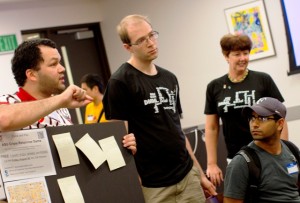
Making social media an effective tool for humanitarian aid, national defense
Posted March 11. 2013

ASU computer science students are pictured conducting a simulated public disaster situation as a test for their software program designed to help coordinate crisis-response operations. Photo: Jessica Slater/ASU
Social media could be used more effectively to support national defense and humanitarian aid efforts through projects being developed by a group of Arizona State University students.
Computer science doctoral students Shamanth Kumar, Fred Morstatter and Huiji Gao have been leading teams in the Data Mining and Machine Learning Lab (DMML) that are refining three software systems that utilize the crowd-sourcing capabilities of social media – primarily Twitter – to gather information useful for responding to public emergencies and natural disasters, or for monitoring potential threats.
They’re working with Huan Liu, a professor in the School of Computing, Informatics, and Decision Systems Engineering, one of ASU’s Ira A. Fulton Schools of Engineering. He directs the DMML, currently overseeing research by 13 doctoral students, a post-doctoral research assistant, four master’s students and an undergraduate.
Liu’s team won a grant of $97,980 from the Defense University Research Instrumentation Program, known as DURIP, to help support some of the work for the projects, called TweetTracker, TweetXplorer, and the ASU Coordination Tracker (ACT) – each of which are funded primarily by the Office of Naval Research.
With access to one percent of the data produced on Twitter, TweetTracker collects and filters large volumes of streamed data, or tweets, and sorts them based on specific topics of interests or key words.
Add any specific word of interest, for example “hurricane,” or select a geographic region, and TweetTracker will gather the targeted tweets and store them. This data can be visualized on a map in near-real time or in the form of a movie. One can also identify the key entities (people, hashtags and URLs) taking part in the discussion of an event.
The powerful search function in TweetTracker can be used to search for keywords, geographic regions, users, and tweets in specific languages to filter relevant information and export it into several textual formats.
TweetXplorer creates advanced visual analytics such as heat maps and retweet network graphs from the data gathered by TweetTracker, which enables an analyst to dig deeper into big data. The two systems complement each other to provide a holistic Twitter data analysis capability to anyone monitoring social media.
The systems could allow the military and first-responders to monitor situations of public interest throughout much of the world by tracking tweets and retweets about events around the globe.

Computer science professor Huan Liu directs the Data Mining and Machine Learning Lab, where students are creating software programs to help harness the power of social media for national defense and humanitarian efforts. Photo: Jessica Slater/ASU
In fact, both systems are already in use by several organizations. For example, TweetTracker and TweetXplorer are being used by Humanity Road, a nonprofit, volunteer-based disaster-response organization. The programs help the group organize response teams to provide relief services to people affected by natural disasters.
If, for example, the word “tsunami” is being tweeted by a significant number of people, Humanity Road workers can use TweetTracker to become aware of a tsunami occurrence and begin focusing their resources on the people affected by it. They can then use TweetXplorer to identify key tweeters – those who can spread information most effectively – and locate the areas that need aid the most.
That was the case in October 2012, when Hurricane Sandy hit the northeastern United States. Humanity Road, with the help of TweetTracker, was able to quickly delegate responsibilities to various volunteers and begin spreading information on disaster preparedness and safety to people who were directly affected by the hurricane.
“This is the most rewarding part of my research,” Kumar says, “seeing organizations like Humanity Road employ these tools in real-world situations. I watched it work during Sandy.”
Kumar is the lead on project TweetTracker and was instrumental in obtaining the DURIP grant. Morstatter is the lead on TweetXplorer.
They are assisted by doctoral student Isaac Jones, a team of master’s students – Ashwin Rajadesingan, Apurv Patki, Vidit Bhatia – and undergraduate Grant Marshall, who have helped to develop and improve the TweetTracker and TweetXplorer systems.
The DMML lab’s ASU Coordination Tracker (ACT) is used for improving the coordination among relief agencies. It collects crowd-sourced requests in crisis situations through the ACT web portal and text messages, and can also assimilate tweets from TweetTracker, to enhance the coordination among responding agencies during a crisis-response effort.
“If someone was to submit requests for resources such as, ‘need water,’ ‘need power,’ or ‘need food,’ different humanitarian organizations would be able to use the system to see the location of origin of these requests,” Jones explains. Simultaneously, the agencies would be able to share the information about the available resources to coordinate an effective response to the requests.
ACT applies data mining techniques to identify the nature of the request and the amount of resource required. This helps streamline communication and coordination, and facilitates multi-organization responses to a single event or disaster.
The ACT project is led by Gao, assisted by doctoral students Xia Hu and Mohammad Abbasi and masters students Suhas Ranganath and Apurv Patki.
Liu’s DURIP grant was won in part because of the results of a campus crisis-response game organized by DMML researchers last summer to test the efficiency of their crowd-sourcing programs.
Simulating a public disaster on ASU’s Tempe campus, students tweeted and sent text messages seeking help. These were captured and monitored using both TweetTracker and Quicknets (a capability provided by the U.S. Naval Surface Warfare Center Dahlgren Division).
Throughout the simulated exercise, DMML researchers monitored the effectiveness of TweetTracker. Experts from Humanity Road then used this information to coordinate an effective response through Quicknets. The team gained valuable feedback on how better equipment would help improve their systems.
The DMML team then knew how to leverage the DURIP grant to update their servers and other hardware that collect, process and store social media data. The team expects to put the new equipment to full use in coming months to improve the capabilities of their systems from the lessons learned in the simulated exercise.
The grant will also be able to provide service to researchers and other agencies interested in using the software systems. The team has already provided their systems to more than seven universities and 22 government agencies.
In the long term, DMML researchers plan to integrate the TweetTracker and TweetXplorer systems to create a single platform for social media data analysis.
TweetTracker continues to collect several million daily tweets, and the DURIP grant will enable them to efficiently process and store social media information in the future.
“These improvements will allow our programs to serve more people, and to serve them better,” Liu says, “and that’s what it’s really all about.”
Written by Rosie Gochnour and Joe Kullman
Media Contact:
Joe Kullman, [email protected]
(480) 965-8122
Ira A. Fulton Schools of Engineering



































